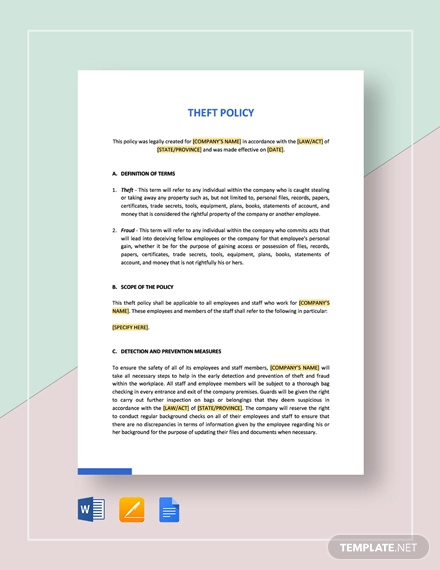How to Create a Theft Policy?
In every company, there should be a level of trust practiced by all employees (not only for rank and file but also for management personnel and officers). The trust being indicated here is not only limited to trusting employees to do their jobs consistently, or trusting the supplier to deliver the goods on time, but trust also relates to keeping your material things safe and secured inside the office.
Theft policies are needed by all companies. It does not matter if you are a small company employing three people, or a large one having around a hundred regular employees in your payroll. Situations like theft can never be avoided that is why companies should prepare themselves if such unfortunate incidents occur in the workplace. Here are some tips on how to create a theft policy.
Theft Policy Example

How to Create a Theft Policy
A theft policy does not need to be a lengthy document. It is not a business plan, feasibility study or contract agreement where it needs at least around 15 to 20 pages for all the contents to be written down. Here are some tips on how to create a theft policy.

Emphasize on the Penalties
Theft policies need to be strict so that the individuals who are caught will be properly disciplined as well as to prevent employees from committing the crime. Your theft policies need to emphasize the penalties which should include heavy sanctions for workplace thieves. It is highly suggested that you include a one-warning system in your theft policy in which the first and the only warning will include the employee having to pay a heavy fine (the amount would probably be two times or three of his/her current salary), if he fails to return the item he/she stole. If the employee commits the act again, he/she will be automatically dismissed from the company with his/her last payment to be given to the victim.
Make the Policy Detailed
Policies, similar to other business documents should be detailed and should not leave any sections which can give leeway to the employee who was caught stealing. Additionally, a detailed theft policy prevents any confusion between the different parties involved in what actions to pursue once the theft has occurred. Policies need to be detailed so that management can decide on what plan or actions to use if an employee is involved with theft inside the office. The plan will firstly include the process or discussion which will occur after the theft involving the victim, thief and the management.
Keep it Short and Concise
Even if the policy is detailed, you don’t need to make it very long as previously mentioned. Keep it short and concise and focus on the details of the penalties and actions being done by the company when a theft occurs. Do not make it longer as it will only confuse the management as well as the person who committed the theft. Make sure all the details and avenues of the policy are fully covered so that the thief will properly be given the correct sanction.
Why do Thefts Occur in the Workplace and How it Can be Prevented?
This question may come off as a very obvious and nonsensical question similar to “why is the earth round?” or “why does a hamburger taste good?” But believe it or not, this question is being asked by companies and corporations more times than they could have imagined.
Thefts that occur in the workplace are mostly committed by single individuals, not by a group or syndicate unless they are planning an armed robbery in the office, warehouse or factory. Thefts usually start with the suspect on how he or she came to decide on why to steal. The theft can either involve office equipment and tools such as desktop computers, laptops, printers, cable wires and chords, or belongings from co-employees like gadgets, bags, clothing and clothing accessories. No matter what the material thing is being stolen, as long as it does not belong personally to you it is classified as theft.
You may think that human resource personnel is the sole reasons why employees with itchy fingers are free to roam around the office taking anything they want. Never put the blame on the human resource as they hire employees based on skills, talent, and character. HR personnel can never predict if a theft will happen since the incident will depend on a number of factors. This situation also applies to top management as they have the final say in the employees who will be hired.
As previously mentioned, thefts occur due to various reasons. The individual who plans to commit the crime may have different reasons on why he or she is planning to steal. He may see it as an opportunity to pay off debts he previously had with persons outside the company so he rather steals within the company instead. Another reason is that he is having financial issues with himself or his family so he resorts to theft. The last reason and probably the most common reason why the individuals resort to theft is that they just have the urge to steal (a.k.a. “kleptomaniacs”).

Theft in the workplace, although cannot be predicted and can be easily prevented. Companies can utilize a number of methods which can aid them in lowering and eventually eradicate theft incidents in the workplace. One method would be creating a very strict theft policy with hefty penalties for the individuals being caught. Additionally, they can also add a section in the policy wherein the persons reporting the theft will be rewarded (either by cash or other company gifts). Another method would be increasing the number of CCTV cameras as these cameras would exponentially help track and catch potential thieves. One other method that companies can use is to have lockers in which all employees need to rent out or use so that employees can place all their belongings in the locker and place a lock on it after.
We hope you found our article on theft policies to be informative as well useful for your own company. You can start working on them as soon as possible.


